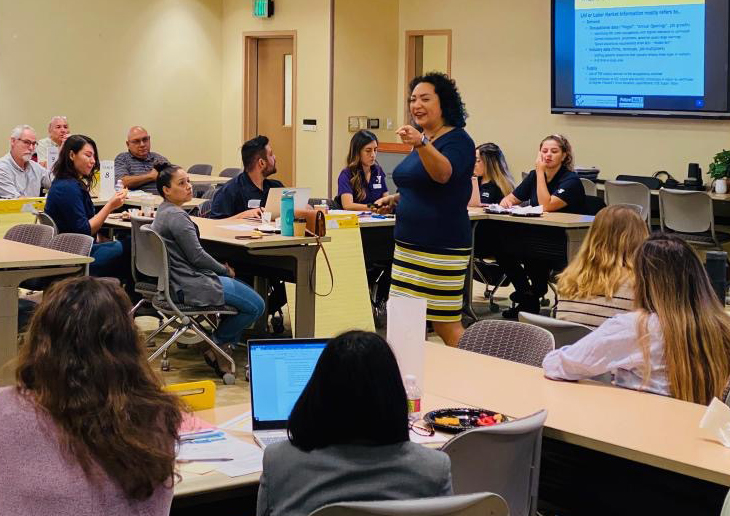Industry Reports Highlight Orange County’s Workforce Needs and Regional Collaborations Feature Story
November 27, 2019

The reports highlighted in this article may be downloaded for free here: OC Sector Analysis Report.
When Jesse Crete was hired by the Orange County Center of Excellence (COE) for labor market research a little over a year ago, she asked Orange County’s community college deans what they wanted. The overwhelming response was better data that was not only relevant, but also accessible. Not an easy task by any means, but that’s exactly what the recently released Orange County Sector Analysis Project reports are.
“I wasn’t interested in creating a report to sit on the shelf,” says Crete, who had a vision for a report that wasn’t just an info-dump, but a creative, collaborative process that could turbo-boost career education programs across the region.
“I wanted something that would engage people and be useful to them for their strategic planning.”
Funded by the regional Strong Workforce Program, a statewide community college initiative focused on assessing and addressing regional labor market gaps, the project is only the second of its kind to be completed in the state. As a whole, it is a collection of several reports that include thorough quantitative and qualitative analyses of each of the eight priority and emerging industry sectors in Orange County and an executive summary that gives a bird’s eye perspective on regional trends across sectors. In addition, key findings and recommendations are provided that can be used to guide and create data-driven plans for expanding and refining career education (CE) programs across the region.
Previously, information on labor market supply and demand was only available on the statewide COE website, but the data is presented in what are “basically giant Excel sheets, and when I say giant, I really mean it,” says Crete. The challenge for Crete and OC COE Research Analyst Jacob Poore was to take this cumbersome data and make it “easily digestible.”
Especially unique is the inclusion of data from 12 focus groups, comprised of CE faculty, deans, and industry experts from community colleges across the region, and the unique analyses and recommendations it elicited.
“The meat of the sector analysis project, and why it was important—and I think why it’s been so well-received—is the qualitative part. It’s getting everyone together in a room and having the conversations, not just about the data,” says Crete, whose research was also supported by the work of Tina Ngo Bartel, director of the San Diego/Imperial County (SDI) COE, and research analyst John Edwards.
According to Saddleback College Advanced Technology and Applied Sciences Dean Anthony Teng, who participated in the focus groups and provided feedback on the COE’s data, “These COE reports provide data-driven evidence that the OC colleges (credit and non-credit) serve the community by preparing the workforce with quality, trained workers. Now, colleges can take that data and use it to make decisions and to provide support for current and future programs that will lead to student success.”
Significantly, the reports help identify employer needs and regional workforce training gaps. By doing this, they help local community college career education programs clarify what career paths might be worthy of attention and new offerings.
“Overall, if we look at the entire region, there is a gap of over 47,000 between jobs offered and awards conferred,” says Crete. In some sectors like health, the gap is small; in others, it is sizable.
“Business and entrepreneurship has by far the greatest demand with almost 13,000 annual openings,” Crete relates. “Since OC community colleges only give out around 3,800 awards in these fields every year, that’s a significant gap.”
Similarly, the energy, construction, and utilities sector has the second-highest demand in the region, with almost 4,900 yearly openings. Yet, according to Crete, “It is one of the smaller awarded sectors with only 694 awards, so that whole sector really needs some love.”
While these gaps pose a serious challenge to the ability of Orange County’s economy to continue to grow, they also provide significant opportunities for prospective employees.
“The LMI data that these COE reports provide is extremely valuable,” says George Bonnand, machine technology instructor at Fullerton College. The specific information in the reports not only demonstrates the increasing need for Fullerton’s CE programs, but also shows the college where they could expand. Speaking of the advanced manufacturing sector, Bonnand explains that the data allows his program to refine its understanding of the sector’s needs while showing faculty “other areas that may need to be addressed, such as maintenance, electro-mechanical technicians, and first-line supervisors.”
According to Teng at Saddleback, “The information provided by the COE reports will guide Saddleback College as it meets the career education needs of the community for credit, non-credit, and contracted training of the current workforce. We want to do big things for our community in preparation for the future. This will help us get there.”
But it’s not just the data in these reports that’s exceptional—these reports are also a record of the groundbreaking collaborations that are guiding the development of Orange County’s award-winning CE programs.
For Cathleen Greiner, regional director of employer engagement for business and entrepreneurship for the OC community colleges, the reports substantiate the benefits of and ongoing need for regional collaboration.
“It’s yet another piece of our tapestry of saying here’s why and how regionalization makes sense in terms of resources, not duplicating things…and really being able to assist our students,” says Greiner. “Our students will be prepared to quickly complete both at the community college and university level to meet the market labor data we’re talking about.”
One of the project’s most exciting findings relates to the development of educational pathways and pipelines that support the transition from non-credit to credit courses. While many people know that non-credit programs are tuition-free, they are unaware that these courses can catapult students into the workforce and into future educational pathways.
“A lot of our students just need a job right now,” explains Crete, making non-credit programs a promising solution for faster employment. Though the jobs that these courses lead to tend to be entry-level and lower-wage, they are extremely effective in helping individuals get a foot in the door and increasing their job prospects.
“Let’s really focus on getting students…in a job making some money, but then also create this pipeline because we want them to be able to continue their education, to be able to get higher-paid occupations and wages,” says Crete, who believes that developing non-credit programs is one of the richest recommendations in the reports.
“For many of our students, particularly immigrant students, non-credit programs offer a very quick and effective alternative to learn skills that can help them get a better job,” says Gustavo Chamorro, Orange County director for the Los Angeles Orange County Regional Consortium, a key supporter and funder of the report. “But non-credit programs can also prepare students to continue on their educational journey to more advanced programs offered at our community colleges.
“Now more than ever, we have to focus our efforts in getting more of our non-credit students prepared to transition to these programs,” adds Chamorro.
Going forward, the COE is preparing for a second research phase that will take analysis of this data and cooperative efforts even further.
“Now we are united and we can bring industry on board,” says Crete, who is enthusiastic about the synergy she hopes will emerge between educators and industry leaders in future focus groups. “The second phase for next year will look at knowledge, skills, and abilities of the occupations that we want to focus on, and it will bring industry into the room.” Colleges will be able to fine-tune their curriculum alignment with industry needs. Plus, deepening connections with industry partners will continue to dispel old perceptions that a bachelor’s is better.
“It’s letting industry say, ‘These are the skills we really need, and if these students have it, we want to hire them,’” says Crete. “So hopefully, we’ll be creating more opportunities for students to get jobs because we’re starting to break down those barriers.”
As CE evolves to fill industry demand, Crete sees positive developments manifesting in two ways. First, the data will allow for more strategic planning, “so when we’re investing time and resources, we’re looking for things that will help us not just this second but for the next few years, and really create those pipelines.” Secondly, Crete hopes that the “eye-opening” collaborations with administration, faculty, and now industry, will continue to deepen and lead to robust programs and innovation.
“This kind of cross-sector analysis project provides both practice and ongoing opportunities for us to really see where we can collaborate,” says Greiner. “It’s cross-sector, it’s across the region, and it’s cross-level. All of that leads to a very rich and powerful matrix that is going to benefit both the economy and our students.”
“Even though it was the OC COE that published the report,” says Crete, “it was the support and work and belief from all these other people in the region…that made it the successful collaboration that it was.
“It was all about the process, the conversations, and looking at information and empowering our region.”
For more information about the Orange County Center of Excellence, visit www.coeccc.net.




